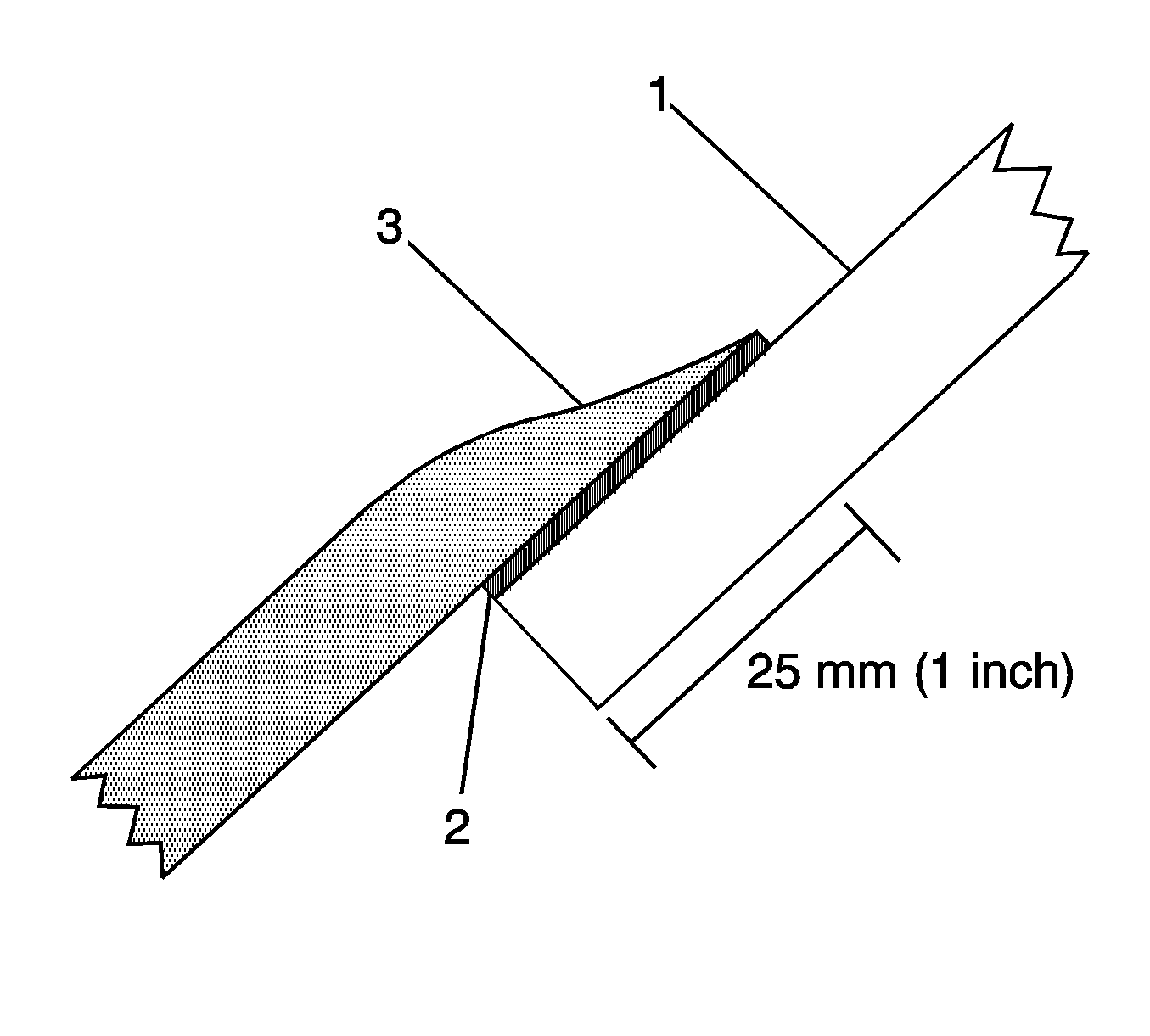For 1990-2009 cars only
Overlap/Backing Plate Sectioning Bonding/Overlap

Important: Before starting the repair, refer to Metal Panel Bonding for proper adhesive applicator preparations and general information.
- Fit the service panel to the vehicle to ensure a proper fit of a maximum 25 mm (1 in) overlap.
- Grind a 25 mm (1 in) area of the outer surface on the vehicle panel to remove any corrosion, E-coat, primers, coatings and galvanizing that may be present (1).
- At the section joint on the service panel, grind a 25 mm (1 in) area of the back side to remove any corrosion, E-coat, primers, coatings and galvanizing that may be present (2).
- Bevel the service panel at the section edge to approximately 10 degrees (3).
- Clean the mating surfaces.
- Apply a 3-6 mm (1/8-1/4 in) bead of metal panel bonding adhesive to both of the mating surfaces.
- Using small acid brush, spread a coat of adhesive to cover all the bare metal surfaces to ensure corrosion protection.
- Apply a 9-13 mm (3/8-1/2 in) bead of metal panel bonding adhesive to the sectioning part mating surfaces.
- Position the service panel to the body. Clamp the service panel into position.
- Install the screws or clamp the overlap sectioning location.
- Using lacquer thinner, remove the excess adhesive from the overlap section.
- Allow the adhesive to cure. Remove the screws or clamps from the overlap section.
- Remove any remaining adhesive where body filler will be applied.
- Recess the screw holes with a punch and hammer as necessary.
- Apply a fiberglass-filled body filler for the overlap section and screw holes for the first coat.
- Apply a lightweight body filler to the overlap section for the second coat.
Important: The adhesive has a 40-50 minute working time.
Important: DO NOT pull the service panels apart after the panels have been joined together. Slide the panels against each other to realign the panels.
Important: Always follow the system manufacturer's instructions for application, handling, and curing.
Overlap/Backing Plate Sectioning Welding
Warning: Refer to Approved Equipment for Collision Repair Warning in the Preface section.
- Fit the service panel to the vehicle to ensure a proper fit.
- Measure and mark a line at the sail panel 120 mm (4 3/4 in) from the back glass opening and 70 mm (2 3/4 in) rearward from the rocker panel locating hole edge of the service panel.
- Cut along the line to trim the service panel.
- Fabricate a 50 mm (2 in) backer plate so that the panel will fit behind the sectioning joint at the sail panel.
- Fabricate a 100 mm (4 in) backer plate for the rocker panel.
- Drill 8 mm (5/16 in) plug weld holes as necessary in the locations noted from the original panel.
- Bevel the sail panel and service panel edges at the sectioned area to approximately 10 degrees.
- Grind a 50 mm (2 in) area of the outer surface on the vehicle to remove any corrosion, E-coat, primers, coatings and galvanizing that may be present.
- At the section area on the service panel, grind a 50 mm (2 in) area of the back side to remove any corrosion, E-coat, primers, coatings and galvanizing that may be present.
- Drill plug weld holes approximately 13 mm (1/2 in) from the edge of the cuts the sectioning areas of the service panel and the original panel.
- Prepare all mating surfaces as necessary.
- Apply GM-approved weld-thru coating or equivalent to all mating surfaces. Refer to Anti-Corrosion Treatment and Repair.
- Position and clamp or screw the backer plate with half of the backer plate exposed at the sectioning joint.
- Position the service panel to overlap the backer plate and 1 1/2 times the thickness up to the original panel.
- Check for proper fit and alignment to the vehicle. Clamp the panels together.
- Plug weld the backer plate accordingly.
- Stitch weld along the entire sectioning joint, make 25 mm (1 in) welds along the seam with 25 mm (1 in) gaps between them.
- Complete the stitch weld.
- Clean and prepare all welded surfaces of the entire sectioning joint.
- Apply a lightweight body filler to the backer plate area.
Note: Leave a gap of 1 1/2 times the thickness of the metal at the sectioning joint to the original panel.
Note: Always follow the system manufacturer's instructions for application, handling, and curing.
